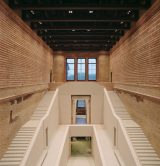A cappella music in Berlin’s Neues Museum: Rundfunkchor Berlin invited its audience to a Wandelkonzert, or moveable concert, in the Neues Museum to discover Richard Strauss as a choral composer.
The museum’s architecture and exhibition recalled the significant role that his encounter with the visual arts, especially of antiquity, played in the composer’s output. Summing up two extended Italian tours and a nine-month journey to Greece and Egypt, he declared: “From that moment on I have remained a Greco-Teuton.”
Strauss’s choral works are seldom performed, not least because of the enormous demands they place on the singers. “What he called for in terms of tessitura and breath technique in his Deutsche Motette went far beyond the normal vocal possibilities”, wrote Strauss’s biographer Ernst Krause. But the pieces are also enchantingly beautiful, a reason in itself to devote an entire concert programme to this composer and then to record it.


